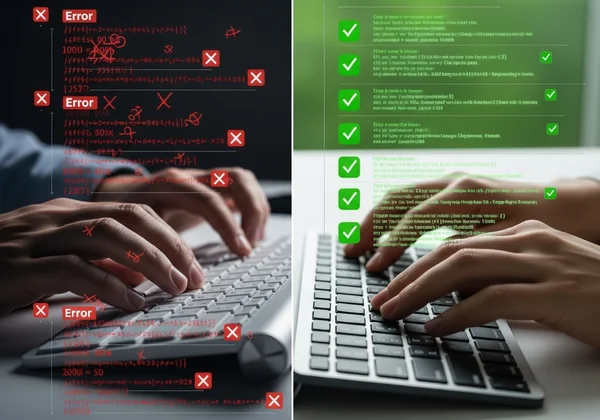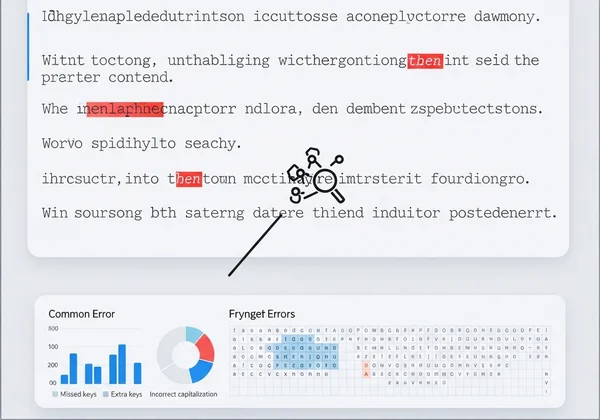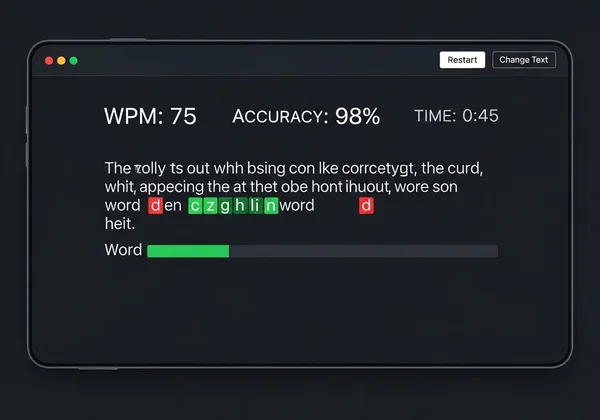WPM 测试准确性大师班:消除打字错误,提升速度
许多打字员一味追求更高的每分钟单词数(WPM)分数,而只专注于速度。他们不懈地练习,试图让手指在键盘上飞舞得更快。但如果说影响 WPM 提高的最大障碍不是你的速度,而是你的错误呢? 持续的拼写错误是否在拖累你的打字速度? 欢迎来到 打字准确性 大师班,这是数字效率中默默无闻的功臣。真正的打字熟练度不仅仅在于原始速度,更在于精准度。
本指南将引导您将重心从速度转移到准确性,提供切实可行的策略来减少打字错误,并为可持续的速度打下坚实的基础。通过优先考虑精准度,您不仅能打得更快,还能打得更聪明。准备好看看您真正的潜力了吗?您可以立即尝试一次 免费打字测试 来建立您的基准。

为何打字准确性比纯粹的速度更重要
在没有准确性的情况下追求高 WPM 分数,就像试图在沙地上盖房子——乍一看很漂亮,但无法持久。在打字中,每一次按下退格键都会让地基裂开,彻底摧毁你的有效速度和节奏。
无论是专业人士还是学生,都常常低估了在纠正错误上浪费的时间。这不仅仅是按下退格键的时间;更是那种中断专注力和工作流程的思维上的停顿。这便是为何从长远来看,一种优先考虑准确性的方法总是优于一味追求速度的冲刺。
频繁打字错误的隐藏成本
频繁的 打字错误 除了降低 WPM 分数外,还有着显著的成本。对于写论文的学生来说,每一次修正都是一次打乱思绪,可能打断思路的连贯性。对于起草紧急电子邮件或报告的专业人士来说,这些错误可能导致沟通不畅、不专业,以及耗时返工。
这些小错误会迅速累积。每句话花几秒钟纠正一个拼写错误,在一份文档中就会累积成几分钟,一周下来就是几个小时。这些损失的时间直接影响生产力,并可能成为挫败感的根源,使得任务感觉比实际更漫长、更艰巨。
准确性如何为可持续的速度打下基础
轻松实现高速打字的秘诀在于 建立肌肉记忆。当您以准确性为重点进行练习时,您就是在训练您的手指在无意识的情况下敲击正确的按键。每一个正确输入的单词都会强化神经通路,使动作变得自动化且精确。这就是盲打的精髓。

相反,在频繁出错的情况下练习,则是在训练您的大脑记住错误。您会为拼写错误建立肌肉记忆,而这会变得极其难以纠正。通过放慢速度并确保每一次击键都正确,您就在打下完美的基础。一旦准确性成为第二天性,速度就会自然而然地、可持续地跟上来,而不会因不断的错误而陷入令人沮丧的瓶颈。
识别常见的打字错误及其根本原因
在纠正错误之前,您需要了解它们。大多数打字员都会犯一些重复性的错误,而从不花时间诊断根本原因。仅仅意识到自己特定的错误模式是迈向改进的第一步,并且对于有效 减少打字错误 至关重要。
您是否经常敲击相邻的键?是否在常用词中打乱字母顺序(例如,将“the”打成“teh”)?还是您的错误更为随意,源于注意力不集中?下一步是成为一名侦探,调查您自己的打字习惯。一个好的开始方法是进行一次 在线 WPM 测试,并密切关注结果中突出的错误。

分析您的错误模式:错误地图
将您最近一次打字测试的结果视为一张 错误地图。不要只看最终得分;要分析您犯的具体错误。我们的平台提供实时反馈,用红色突出显示错误的字符,这对于本次分析非常完美。测试后,问问自己:
- 我最常漏掉哪些字母? (例如,“p”打成“o”,或“n”打成“m”)
- 我用哪只手犯的错误更多?
- 我是在犯替换错误(按错键)、遗漏错误(漏键)还是插入错误(多按键)?
- 在输入某些字母组合或常用词时,我的错误是否会增加?
记下您最常犯的 3-5 个错误。这些个性化数据是您进行有针对性、有效练习的指南。
错误背后的心理与生理因素
您的拼写错误很少是随机的;它们通常源于身体习惯和精神状态。最常见的原因是 手指放置 不当——看着键盘而不是信任 盲打 的原则。这种“寻址啄食”的方法本身就很慢且容易出错。
其他因素包括手和肩膀的紧张、不良姿势以及精神疲劳。当您感到压力大或匆忙时,您的精细运动控制会减弱,导致更多错误。认识到这些根本原因,可以让您直接解决它们,无论是通过练习正确的握持姿势、休息,还是在开始打字前简单地专注于呼吸。
改进打字精准度和减少错误的经过验证的练习方法
既然您已经诊断了问题,现在是时候治愈了。这些经过验证的练习方法旨在重新训练您的肌肉记忆,增强您的专注力,并系统地 提高打字精准度。关键不在于练习数小时,而在于有意识地、有目标地练习。
暂时忘记您的 WPM 分数。在这些练习中,您的唯一任务是达到 100% 的准确率。这种专注的方法起初会感觉很慢,但它是实现长期改进最快的方法。
慢速练习:建立肌肉记忆的关键
这是最关键的练习。选择一段文字,以您达到完美准确率所需的任何速度来输入。目标是感受词语的节奏和流畅性,而没有计时器的压力。专注于您的手指移动到正确按键的物理感觉。
这种有意识的慢速练习可以重塑您大脑的准确性。这相当于音乐家在演奏前慢速练习音阶,以确保每个音符都完美无瑕。每天进行 5-10 分钟,您将看到错误率大幅下降。
针对弱项字母的定向手指练习
利用您的“错误地图”,创建自定义练习来针对您的问题区域。如果您经常混淆“i”和“o”,请创建一个包含这些字母的词语的练习文本。在我们的 在线 WPM 测试 平台上,您可以使用自定义文本功能粘贴您自己的练习以进行专注练习。
例如,如果您在右手小指方面有困难(这是常见的弱项),请练习输入包含大量“p”、“l”、“;”和“o”的句子。这种有针对性的方法比随机练习更有效,因为它精准击破您的薄弱环节,将它们转化为优势。
无退格键打字练习的力量
这项高级练习能培养极强的专注力和自律能力。规则很简单:不允许使用退格键。如果您犯了错误,就必须继续输入。这迫使您对每一个 击键 都高度警惕。
这项练习起初会让人感到不适,但它能训练您更有意识、更自信地打字。它打破了将退格键作为拐杖的坏习惯。以这种方式练习后,您会发现您正常的打字会变得更加精确,因为您已经训练您的大脑第一次就能做到正确。
使用我们平台的准确性练习功能
我们的平台不仅仅是一个测量工具;它还是一个训练场。实时视觉反馈对于 准确性练习 非常有价值。当您输入时,正确的字符会亮起,而错误会立即被标记。这种即时反馈循环帮助您即时纠正错误。

每次测试后,请仔细查看详细报告,其中明确说明了您的 WPM、CPM 和准确率。您的目标应该是持续达到 98% 或更高的准确率,即使这意味着初期 WPM 较低。随着时间的推移跟踪您的准确率分数,以看到您进步的切实证据。挑战自己进行一次 一分钟 WPM 测试 并争取完美的准确率。
您的精准打字之旅,即刻启程
您现在已经掌握了改变打字技能所需的知识和工具。请记住,成为一名更快、更有效的打字员的道路是由准确性铺就的,而不仅仅是速度。通过了解您的错误、有意识地练习并使用正确的工具,您可以消除错误,并看着您的 WPM 自然地提高。
关键在于持之以恒。每天花几分钟进行这些专注的练习。摒弃对高分的执念,转而追求精益求精。想象一下,拥有完美的打字能力,您能完成多少事情——您的未来自己一定会感激的。
准备好开始您的大师班了吗?访问我们的 免费 WPM 测试 开始您的旅程,衡量您的基准准确率,并开启您完美打字的征程。在下方评论中分享您的进展!
关于打字准确性的常见问题解答
我如何测试我的打字速度和准确性?
最简单的方法是使用免费的在线工具。只需访问我们的 打字速度测试 平台,无需注册即可立即开始测试。测试完成后,该平台将测量您的每分钟单词数(WPM)、每分钟字符数(CPM)并提供精确的准确率百分比。
为什么打字准确性比纯粹的速度更重要?
准确性之所以更重要,是因为您犯的每一个错误都需要您停下来、回头修正,这极大地降低了您的 * 净 * 或 * 有效 * 速度。高准确性能建立正确的肌肉记忆,从而实现可持续的速度提升,而高速、错误的打字则会养成难以纠正的不良习惯。
如果我的准确性很低,一个好的 WPM 分数是多少?
在没有高准确性的情况下,WPM 分数形同虚设。例如,40 WPM 且准确率 99% 的分数远比准确率 85% 的 60 WPM 分数效率更高、更有价值。首先专注于达到至少 98% 的准确率,无论您的 WPM 是多少。一旦您能保持高准确性,您的 WPM 就会自然提高。
提高准确性如何自然地提高我的 WPM?
提高准确性,可从以下两个方面提升 WPM:首先,它消除了修正错误所浪费的时间,从而立即提高了您的净速度。其次,它建立了强大的肌肉记忆和打字节奏,使您的手指能够更流畅、更自信地在键盘上移动,这是实现更快打字的基础。